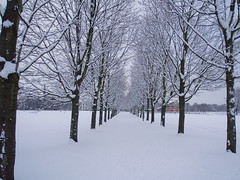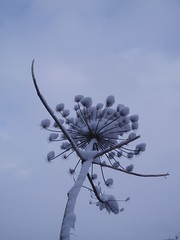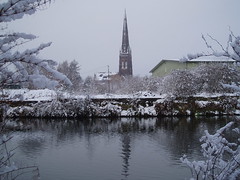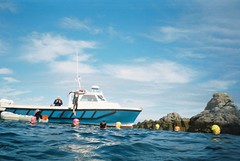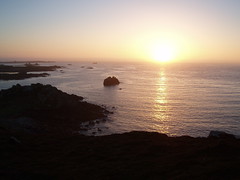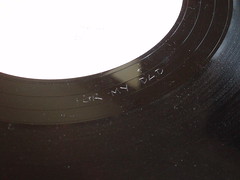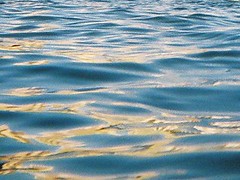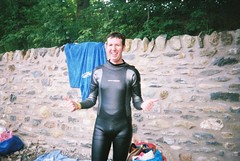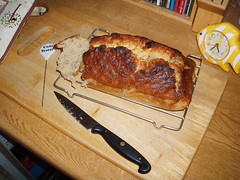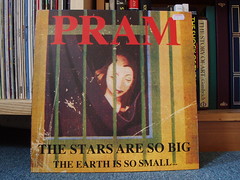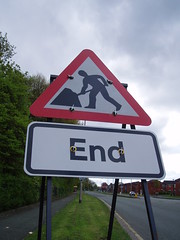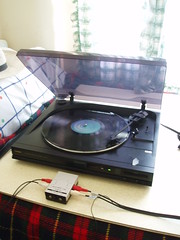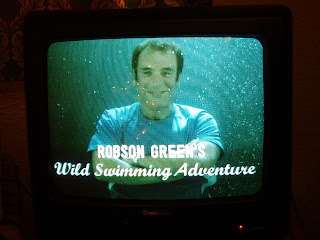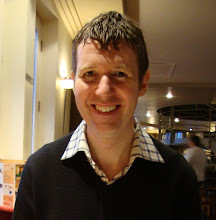Wednesday, December 22, 2010
December Snow
Last Friday night was another unseasonably heavy snowfall across the country, and on Saturday morning like everyone else I woke up to a bright white landscape. I know this isn't good news for everyone, but I still find a covering of snow to be a little bit magical. I suppose it takes me back to my childhood and memories of school being closed, the normal rules of life are suspended.
Buoyed by this feeling I decided on a whim I'd take my camera and go for a walk up to the park and round the river. These are places that I've been running through the past year, watching with interest how they've changed with the seasons, but heavy snow is something else again in the way it transforms our everyday surroundings. The familiar is rendered strangely unrecognisable: we can become disoriented as regular landmarks are hidden, while at the same time things that usually go unnoticed are suddenly revealed - or some cases not only revealed but transmogrified.
For example, just what is this?
It's a great opportunity to see the world anew, or at least just a little askew - even the familar Warrington landmarks can look refreshed with a silvery dusting:
As with all magic, the snow also has its dangers: travel can become hazardous and the everyday business of life can be disrupted. It's a reminder of how fragile the structures and routines of our lives really are, and of how little control we really have over them (and I'd rather be reminded of that by something gentle and relatively benign, like snow, rather than say by an earthquake). I think it's telling when people try (quite literally) to plough on when the sensible thing to do is just stop for a while. But if you are able to take time out then the world can suddenly seem like a friendlier and more relaxed place.
So even though I don't know if the snow will cause problems travelling back tomorrow to spend Christmas with my family, I'm feeling quite relaxed - I hardly dare say chilled in fact - about it. And even if all other modes of transport are disrupted, I know now that I might still have options...
Merry Christmas!
Monday, December 13, 2010
OSS December Dip: Plum Pudding Plunge
About a week ago I travelled down to Parliament Hill Lido in London to take part in the Outdoor Swimming Society's 2010 December Dip (aka "the plum pudding plunge"), an annual fund-raising event for the OSS. It's pretty simple: a bunch of people line up at the edge of the pool, jump in and swim, with the aim of completing two widths of the lido before getting out again as fast as possible. Brrr!
The Dip was preceded by pep talks from Kate Rew (the OSS founder) and two great guest speakers - Jessica Hynes (actress, writer and comedian best known to me for her work on the insanely brilliant Spaced - my favourite ever TV sitcom) and Colin Hill (distance swimmer and founder of the Great Swim series of events). Jessica spoke about her enthusiasm for the Outdoor Swimming Society's mission to promote having fun of all kinds in water outdoors (the society is very egalitarian: all you have to do to call yourself a member is to like being in water outdoors, although by signing up for free on their website you also receive a regular email newsletter); Colin talked about the psychology of longer outdoor swims, and suggested ways that indoor pool swimming over the winter could help prepare (a point that outdoor swimmers don't always seem to concede).
After the talks came the actual plunge. I'd swum outdoors in London almost exactly a year earlier, but that was in the heated pool at the Oasis - this time the water was an icy 0.1C (32.2F), and with patches of snow around the poolside to add atmosphere. All through the previous week I'd become increasingly aware of the cold, until even washing my hands in cold water had made me think nervously about the event; but as the air temperature felt relatively mild on the day I didn't really feel worried until the last few minutes before when everyone lined up by the water (and I tried not to think of the risks I'd read about cold water immersion - hopefully this wouldn't be the last thing I ever did...).
Everyone had their own method of entering the water, but after my experiences swimming the Scillies my preferred technique is simply to jump straight in (one useful bit of advice is to breathe out as you enter the water so that you naturally take an in-breath when you surface) and then swim like mad. The cold water made it difficult to breath normally and impaired my swimming ability (while also making my hands and feet feel literally as if they were encased in blocks of ice) so I was glad to complete my two widths and jump back out again.
Afterwards it took a while to get warmed up again but to help there was hot chocolate, mince pies, ginger wine and a very congenial atmosphere. I talked to a few people about where they'd come from and the kind of swimming they did, which was good as I don't really talk to many other swimmers - I think that outdoor swimming does tend to be a bit more social than pool swimming. I'm not sure that I had an immediate endorphin rush but I did feel extremely mellow and relaxed for the rest of the day, and that's good enough for me.
There are reports of the event online from Sky News (which has video footage, although you can't see me in it) and the BBC. In hindsight I can't say that I had a particularly definite reason for doing the dip, except that it seemed like a good way to round off 2010 as a year of outdoor swimming. I'm continuing to swim indoors (I rarely stop these days), but now I'm also looking forward to more outdoor dips in 2011.
Happy festive swimming!
Sunday, November 21, 2010
Delia Derbyshire
Last summer I threw out a lot of my old cassette tapes as part of a big clear out, but amongst those that I kept was a recording of "Blue Veils and Golden Sands" - a BBC 4 radio play broadcast in 2002 about Delia Derbyshire, considered by many to be "the unsung heroine of British electronic music" due to her work at the BBC Radiophonic Workshop in the 1960s. She's probably most famous for producing the original arrangement of the Doctor Who theme music.
I kept the tape aside to listen to, before promptly forgetting all about it. In the meantime references to Delia kept popping up, most memorably in an article by Warren Ellis called "The Pops and Crackles of Vinyl Poltergeists" in Wired UK. In it Ellis talks about "hauntology" - a contemporary musical phenomenon which frequently references the often eerie 70's and 80's electronica produced by the Radiophonic Workshop. (As he suggests, tracks on Belbury Poly's relatively recent album "From An Ancient Star" sound like they could have accompanied "The Tomorrow People" or "Blakes 7", thirty years or so earlier.)
A couple of months ago the tape turned up again as part of another clear up, and this time I finally listened to it one Sunday afternoon. It focuses mainly on Delia's time with the BBC and her interest in "abstract sound" (in part perhaps inspired by the air raid sirens she heard as a child during the war), before she became disillusioned with the direction of electronic music in the mid-70's. This is cross-cut with episodes from her later life in the 1990's when a new generation of musicians (including Peter Kember, AKA Sonic Boom, played by himself here) rekindled her enthusiasm to return to music.
Given its 30 minute running time it's evitable that the play had to leave out a lot of detail about Delia's life and many of the projects that she was involved in, especially those outside of the BBC. However the dramatisation of how she put together the Doctor Who theme is fascinating - in an era before synthesisers, the process of creating these "electronic" sounds was simultaneously highly organic, extremely primitive and labour-intensive. Very ordinary sounds (for example plucking a guitar string or striking a metal lampshade) would be transformed by esoteric analogue equipment to produce other-worldly effects which were then spliced and looped on sections of tape.
To me the original Doctor Who theme still sounds incredible: haunting and slightly disturbing, like the universe that the Doctor himself inhabits. You can listen to it on the BBC website ("Lost tapes of the Dr Who composer"), alongside a number of other audio clips of Delia's work, including a couple from "Blue Veils and Golden Sands", produced for a documentary about the Tuareg people of the Sahara (the demo clip in particular gives some insight into how sounds would be transformed). Many more audio clips (including "Music of Spheres", which features a symphony of sirens) can be found - along with much more information on Delia's life and career (both of which sadly ended when she died in 2001) - at www.delia-derbyshire.org.
It looks like the play has been repeated on BBC 7 quite a few times over the last couple of years, but unfortunately it's not currently available on the iPlayer. It's definitely worth a listen if you have an interest at all in the history of electronic music, or are just a fan of the old Doctor Who theme, and want to learn more about the work of this amazing pioneer.
Saturday, November 6, 2010
The Truth About Leaves on the Line
As frequent travellers will be only too painfully aware, one of the staples of British rail journeys are the intercom announcements by train managers explaining why the service you're on is now delayed, redirected, terminated, side-lined, or whatever. These explanations can vary wildly from the sensibly mundane through to the slightly surreal ("bovine incursion"* is one of my favourites), to the almost completely cryptic.
For me the most recent example of the latter occurred during my last trip back from Oxford: the train manager haltingly explained that the driver had been forced to use the train's one-shot sand dispenser to come to a stop at a signal, as a result of which we were no longer able to run at full line speed and there would be a further delay when we did finally make it to the next station. I'd considered myself a fairly regular rail traveller and I thought I'd heard everything, but this was new to me. "One-shot sand dispenser?" What was that all about? It sounded technical, mysterious and possibly a bit dangerous, and the next day I did a bit of poking on the internet to try and learn more.
Stumbling across an enlightening article from the Independent revealed the shocking truth: trains really do have single-use sand dispensers that provide emergency braking assistance when there's reduced traction between the wheels and the rail. These slippery rail conditions can be caused by moist fallen leaf debris on the track - the infamous "leaves on the line" - and it's become a more common problem now because today's trains use disc brakes. These are generally superior to the previous block brakes - but unlike block brakes, they aren't as effective in "removing leaf mould and other debris".
It was a bit of an eye-opener. I'd found the idea that fallen leaves could be a hazard for several hundred tonnes of passenger train a bit laughable, and the phrases "leaves on the line" and "the wrong kind of snow" just sounded like nonsense excuses for poor service. It's odd but salutary to find out after all these years that it was a real issue after all, although it's also indicative of how poor train operators are at explaining these problems - or maybe of how little the travelling public expect to be told the truth.
So aside from the specifics, I'm sure that buried somewhere (maybe under more fallen leaves?) there's also a wider lesson about trust and communication, which could perhaps be applied to other situations where technical problems have to be explained to a lay audience. It might be worth thinking about next time you're (say) stranded at Stafford station due to leaves on the line.
* Cows on the line to you and me.
Sunday, September 5, 2010
Swimming in the Scillies
I've been meaning for a while now to write about my swimming holiday in the Isles of Scilly last month. I went with the company Swimtrek, which runs a number of similar holidays all over the world, and while the waters in Egypt or Greece must be much warmer, something drew me to the Scillies when I booked the trip back in February. I'd had a vague interest in swimming with seals, and the opportunity offered by this holiday to combine it with swimming between some islands seemed too good to miss.
It was a great experience, though quite intense - I'm not used to swimming in the sea and I'm not used to being around a lot of people that I don't know either. But the group I was with was great - a great mixture of experience levels and speeds, but all very friendly - and we were looked after throughout the trip by phenomenal guides Jerry and Cordelia, always supportive, good humoured and working hard to keep things running smoothly.
Before the trip I'd hoped to do the swims without a wetsuit, but from the first acclimatisation swim (a short sprint across the harbour and back on the opening evening) it was clear that the water would be much colder than I'd anticipated (at anywhere between 15-17C it was frequently and euphemistically referred to as "refreshing"). I managed without the wetsuit for the short crossing between the islands of St. Martin's and Tean, and for a much longer swim to Tresco - however by the end of that I had quite a severe case of the shivers. I was okay (and pleased to have accomplished it), but I wore the wetsuit for the rest of the crossings.
The advertised plan was to circumnavigate the islands over the course of the five days, with total daily distances averaging around 3km - but the changeable weather and tidal patterns in the islands meant that the guides relied on the advice from our boat's captain "Uncle" Ken (looking the part with his long white beard) as to what was possible each day. In the event we missed out some crossings and did others in the "opposite" direction, and I wish I'd kept note at the time of each as by the end they had begun to blur into each other - a feeling exacerbated by getting into a "flow state" during most swims, where my sense of time seemed to collapse into a single ongoing "now". For me that's the best that swimming can get - almost a transcendent experience.
Aside from the swims, there were so many memorable high points and funny incidents - just a few included: an afternoon swim with some locals in the cove at Peninnis Head (reached after a "hands, feet and bum" scramble down huge granite boulders); swimming over underwater "forests" of seaweed containing fish, crabs and starfish; the collection of ship-wrecked figureheads at Valhalla on Tresco; the wonderful Mincarlo Guesthouse where we stayed; listening to a performance of sea shanties; and of course, swimming with the seals:
Beyond that even, the Scillies themselves are quite amazing - especially when the sun is shining - and if I were to change anything I might have tried to stay a little longer to see more of the islands. We were at least fortunate to have a couple of days of wonderful weather: one evening we enjoyed a wonderful evening at the Turk's Head pub on St. Agnes before walking across a sand bar to see a magnificent sunset from the neighbouring island of Gugh:
On the last morning I was able to take a boat trip out round the Bishop Rock lighthouse - quite remote and just a little sinister, even on a bright sunny day. On the way we saw numerous meandering basking sharks just below the surface; more seals; a gannet diving out of the sky like an arrow to plunge into the water after fish (an incredible sight); and even a lone puffin, eyeing our boat with suspicion as it bobbed away from us. It was a great end to an amazing holiday.
I suppose even though it's been over a month since I got back, I'm still assimilating my experiences. For some reason I find it difficult to quite believe that I swam the distances I did in the sea, and while I gained some confidence with sea swimming but I've since still found it difficult swimming outdoors in a lake. However I now have a better appreciation of my own reactions to cold water immersion, and I've been enjoying my less intensive pool swimming, without the need now to practice going 2-3km each time. But I do know that I had a wonderful time, and I would love to go back to the Scillies one day - and maybe even do the swimming again!
Tuesday, June 29, 2010
How to make a vinyl record
I saw an interesting article in Saturday's Guardian newspaper on How to make a vinyl record. It was in a section called "Disappearing acts", which sounded a little depressing - although actually it seems that a few die-hard bands are still putting enough material out on vinyl to keep the industry going for a bit longer.
It's a good read if you're at all curious about the industrial process used to press records, and it also touches on some of the reasons why vinyl still has its fans. I had to suppress a cynical snort when I read about the "superior sound quality" of vinyl (possibly true in principle, but in my experience often not realised in practice - I have some pressings that are so poor that it sounds as if someone was vigorously sweeping the floor during the recording) - however I agree with the appeal of a "personal, tactile relationship" with the discs and their sleeve artwork (surely there has been no greater canvas than the 12"x12" LP sleeve?).
Also, reading this article reminded me of another obscure pleasure of vinyl: the little messages etched in the run-out groove of some records (I guess made by the engineer when the original lacquer was cut). For example, my 12" of Suede's epic "Stay Together" has "A big hand to D D, Mr G K and company!" on the A-side and simply "For My Dad" on the B-side:
As I've written previously, my own record collection has of late been experiencing a bit of a quiet renaissance (helped by the purchase of a new needle for my turntable). There is definitely something almost ritualistic about the hands-on process of playing a record, compared to the ease of putting on a CD or MP3, and it continues to fascinate me. In the meantime it's heartening to read that my old friend vinyl isn't quite dead just yet.
Tuesday, June 22, 2010
Llandudno Sea Swim
On Saturday I did my first ever real sea swim - 1500m along the bay between the Great and Little Ormes in Llandudno - as part of the Blue Seventy Llandudno Sea Swim run by Xtra Mile Events. I'd decided to do it in preparation for a holiday at the end of July, which will involve swimming between some of the Scilly Isles. As I'd never properly swum in the sea I felt I could use the experience in Llandudno to improve my confidence.
I'd been trying to think positive thoughts in the week beforehand, reminding myself that I routinely swim further than 1500m in the pool; that I'd done a number of outdoor swims in the last few months; and that my swimming instructor had told me my technique was fine. In spite of that I felt nervous by the time I arrived at the seafront, and it didn't help seeing the distances between the big yellow course buoys (before the tide came in, still lying on the beach) - it looked a long way! Also, in spite of the sun there was a persistent chilly breeze from the sea, and the waves rolling into the shore looked bigger than I'd expected. Was this really a good idea?
Fortunately I'd arranged to meet up with a great mother-and-daughter couple that I'd met through the OSS social swims at Hatchmere, and we gave each other moral support as we made our way to the start and changed into our wetsuits with the other swimmers. Everyone looked very serious (but I suppose that's the effect of wearing a wetsuit - whilst simultaneously making you also look quite ridiculous) and I was feeling increasingly tense waiting around for the organisers to give the safety briefing. Finally the rather fetching lilac race swim hats were handed out and we were off, staggering barefoot down the beach over hard pebbles (ouch!) to the starting buoys, which were now bobbing up and down vigorously with the waves.
I wasn't feeling too confident as I waded in near the back. The waves seemed rough as we made our way out into the deeper water for the start, and I felt like I was being pushed around a lot by the sea. The left lens of my goggles let in some water but I wasn't really able to adjust them. Really, what was I even doing here?
The signal was given for every one to set off, and I trailed the surge of lilac caps and flailing arms towards the first pair of buoys. The first few minutes seemed mad; I felt like I was being tossed up and down like a piece of driftwood without any control. Swimming breaststroke in order to see where I was going, I didn't feel like I could possibly make any headway in these conditions. The distance buoys marking out the course kept disappearing out of sight as the waves carried me several feet up and down. Surely I couldn't cover 1500m of this? Perhaps I should stop now?
And then quite suddenly something changed - I realised that I was already some distance past the starting buoys, despite appearances it was possible to ride the waves quite comfortably, and - shock! I started to relax and enjoy just being in the sea. Continuing with breaststroke (and occasional bursts of front crawl, as I felt more confident) I took in the sights as I slowly but surely made progress: sunshine, blue skies, the white buildings on the promenade to the left and the green waves rolling in from the right, the support kayaks bobbing up and down. I was swimming in a race in the sea! And it was fantastic! Yaay!
I stopped worrying about the distance, kept up a steady rhythm, and lost track of time. All of a sudden the last yellow buoy seemed to appear and I saw the support kayakers directing the swimmer just ahead of me back to the shore. I followed him and staggered up the boat launch back to dry land. I'd enjoyed it so much that I was almost sorry that I'd reached the end, and I was so glad that I'd done it. A lot of the swimmers had come to race but I was happy just to have completed the distance, and I'd conquered many of my fears of swimming in the sea.
I also felt that I learned a lot about what I need to work leading up to swimming in the Scillies trip. I think most importantly "sighting" (i.e. periodically checking and correcting your course), swimming in more of a straight line, and not getting too worried about going off course. People talk a lot about swimming being as much about good technique as about fitness, but I'm realising now that confidence and mental attitude also plays a big part, especially outdoors.
Afterwards I caught up with my Hatchmere friends (who I'd lost somewhere on the swim - I was the one in a lilac hat, didn't you see me? Um...). I think we'd all done really well just to start the race and achieve our goals of making it to the finish, but I thought that they both had reason to be particularly proud: the mother was recovering from a hip replacement, and her daughter had stayed with her to give encouragement and support. It was inspiring, and why swimming can be so great sometimes.
After a few pints at the pub with a group of their friends who'd come along to watch, it was time to catch the train back home in a pleasantly tired stupor. I couldn't have had a better end to a fantastic day than watching the north Wales coast roll past in the glow of the late evening sun, feeling a real sense of achievement and now looking forward to swimming the Scillies later in the year.
Saturday, May 29, 2010
OSS Derwentwater Swimming Weekend
Last weekend I went up to Derwentwater for a couple of open water events run by the Outdoor Swimming Society as part of the Keswick Mountain Festival.
Although it was only two days, it was a big weekend for me. Saturday morning saw a number of "swim clinics" taking place on the lakeshore - I'd signed up for the beginner's session, which (aside from the 9am start!) was great for me: I've swum twice this year locally at Hatchmere lake (my wetsuit proved absolutely essential in water reportedly at 15C), but I've struggled at times to translate my pool experience into the great outdoors.
During the session the two coaches Neil Bowers and Barry Jamieson had some excellent advice for cold water acclimatisation and swimming technique, which we were also able to practice during the session. Neil emphasised that the physiological reaction on entering cold water (i.e. gasping for breath) never goes away, and so the best way to acclimatise is to take some time getting used to the water before starting to swim, rather than zooming off as fast as possible. Splashing water on your face and neck can also help, as can putting your face into the water and breathing out slowly a few times (also a good opportunity to check the fit of your goggles).
Neil then introduced The Three R's of outdoor swimming: relaxation, rotation and rhythm. A relaxed state of mind means your swimming will be more comfortable; rotation of the body while swimming crawl provides a more efficient swimming style; and getting into a rhythm helps you to sustain a steady pace through the water. He also covered bilateral breathing (I feel smug since I do that anyway) and "sighting" (i.e. looking up periodically to check your course while maintaining your stroke), but The Three R's made the biggest impression on me and by the end of the (hugely enjoyable) session I felt much more confident about tackling a bigger swim.
That opportunity came on Sunday with the OSS mass swim on Sunday and 250 swimmers gathered back on the lakeshore. The original plan to swim around a small island in the lake had been changed at the last minute due to low water levels and the risk of blue-green algae blooms; the course in the end was a circuit around two yellow buoys (presumably left over from the earlier triathlon).
It was a shame not to be able to do the more scenic route around the island (and the buoys seemed to make some people think it was a race, with less confident swimmers like myself unable to stay out of the way of the wannabe triathletes). But it was also a reminder that swimming outdoors means respecting the conditions on the day, and I still had plenty of memorable moments: chatting to people before and after the swim; the sunshine and blue sky; seeing the lake bed a few feet below me through hazy greenish water; feeling soft spongey weed beneath bare feet when entering and exiting the lake; a trio of ducks flying low overhead as I turned to breath; and the whole "wetsuit soup" of swimmers having to stop for a few minutes mid-swim while a tourist boat cut across the course.
In the end I managed four circuits swimming a combination of breast stroke and front crawl; the swimming was still not as easy as I'd liked but worked best when I remembered my Three R's from the previous day and managed to relax, rotate and enjoy myself. And I felt a little emotional being helped from the water at the end by the OSS volunteers, including founder Kate Rew.
That afternoon I went to Kate's Q&A session where she talked about "wild swimming". The audience was quite small in contrast to the huge numbers taking part in the earlier swimming event, but I enjoyed hearing her talk about her experiences of outdoor swimming and her inspiration in setting up the OSS. (To get a taste you can see a short film with Kate on the Guardian website about Swimming in Byron Country.) For me, swimming outdoors is as much about experiencing the world in a different way to normal everyday life - feeling the cold water, being able to see the sky and trees - and it was nice to be reminded of that too.
(With all that going on I didn't do any walking while I was in Keswick - unless you count going between the town, the festival site and the lake. But I did visit the Puzzling Place, which has some genuinely fascinating sensory illusions - mainly optical, but don't miss the "anti-gravity room" if you ever go there - and took a boat trip around Derwentwater.)
So, the last few days have been a bit of a comedown from all that excitement. I'm looking forward to the next outdoor swim next weekend, but this weekend I'm having a bit of a break. In the meantime my pictures from the weekend are on Flickr (got them back from Boots yesterday!) ... and finally I'd also like to recommend the Cartwheel Guest House in Keswick - it's a really nice B&B near the centre of town, but owners Tina and Bernie are great people and went above and beyond in making my stay really enjoyable. And of course a big thank you to all the OSS volunteers who worked to make the swim clinics and the mass swim happen for the rest of us to enjoy.
Happy swimming!
Monday, May 3, 2010
May Bank Holiday: banana loaf, records and rain
I've had quite a nice May Bank Holiday Monday, in spite of the fact that a) it's been a bit on the chilly side, and b) that apparently I single-handedly caused hours of rain in the afternoon simply by hanging out my wet sheets in the yard (a kind of British Summertime voodoo).
After running this morning I decided I would finally make a banana loaf using the over-ripe bananas that I've been uh "saving" (along with some out-of-date almonds that I found in the cupboard). It worked out really well - a big, heavy four-banana breeze-block of a cake. It's nice and tasty (even if it doesn't count as one of my five-a-day).
Also now that I have my records arranged in some proper shelves rather than a couple of old boxes I've been listening to a few that I'd forgotten about - including Massive Attack's "Protection" and "The Stars Are So Big, The Earth Is So Small ... Stay As You Are" by experimental (i.e. probably unlistenable for most of you) 1990's band Pram. I really like the cover:
So all in all it's been a very pleasant - if somewhat damp - day. Fingers crossed for better weather tomorrow when I'm in Manchester!
Job done
In their 2001 track "Harder Better Faster Stronger", Daft Punk suggested that "work is never over" - in spite of this, I've just finished six months working as a contract programmer. It's been good: interesting, educational, lucrative and fun, and now I've finished it seems appropriate to reflect on some of what I learned from the experience.
Perhaps the biggest difference between this and my previous working life was that this time I was telecommuting i.e. working from home. This was possible because I was developing essentially stand-alone software projects, but before I began I was concerned about what home working would be like: basically, could I handle the isolation and the temptations to - oh, I don't know, wander off and do the laundry instead?
I found some relevant advice in a chapter from Miles Burke's book The Principles of Successful Freelancing. For me the most useful suggestions were:
- Set up home office space: this was my spare bedroom with my old desktop computer (upgraded to dual-boot into Ubuntu Linux). Having a dedicated space (and machine) made it easier to start work and stay focused, by providing a physical environment that I associated with working.
- Keep rigorous track of the hours you've worked: Miles' book recommended a bunch of online tools but I found that a simple spreadsheet worked fine for me. Keeping track helped me stay focused and disciplined - when I was on work time then I really did do work, and when I'd finished I knew that I'd really worked my full hours that week.
- Have a work schedule set up ahead of time: this was especially useful at the start as I worked half-time and wanted to fit other commitments in around my work. I did deviate from the schedule sometimes, but it was good to have something to deviate from - and it also meant that for example I never felt I had to work weekends to catch up.
It turned out that I didn't really suffer from a sense of isolation, possibly because my collaborators were very good at staying in email contact. I also made visits to the physical workplace every few weeks, and while the travelling was often tedious (the one-hour stops at Birmingham New Street station will not be missed), contact with the project collaborators, end users and other real people more than made up for it.
Another major difference for me was working exclusively on one "closed" project at a time (I'd previously been used to juggling a disparate mixture of concurrent open-ended and cyclical projects). The resulting narrow focus gave me a sense of clarity that I'd often missed in the past; though at the same time, there was no escape if the going got tough - I just had to plow through it. Also as a contractor I felt less personal attachment to the actual finished code (although I remained deeply committed to doing the best job that I could), and less inclined to spend "work time" on learning about new stuff unless it contributed directly to the project.
Finally, I learnt a few things about being a contractor rather than a full employee that I wish I'd known beforehand - for example, since I used my own computing equipment I wished I'd negotiated some concessions for that, and I also hadn't realised I wasn't entitled to public or company holidays. Sometimes you pay to learn - at least I'll know what to check in future.
Overall though the experience was really good, both in terms of the actual work and also in terms of what I learned about myself. I feel more confident in my programming and in my ability to manage and deliver these time-bound projects. So while my time is now my own again I know there are aspects that I'll miss, but I'm also grateful to have had the opportunity while it lasted.
Friday, January 15, 2010
The hope of Audacity: vinyl conversion tips
Avid readers of this blog may remember that one of my projects last year was to convert my favourite vinyl records to a digital format. It took me a while - in the end I converted around 660 tracks from about 120 different records (LPs, 12"s and 7"s, with a couple of 10"s for good measure!), which added up to over 40 hours worth of music.
I started the project sometime in mid-March last year and completed it sometime in mid-July, and having been listening to the resulting tracks on my laptop since then, I thought it was high time that I wrote up what I learned about the process. So here it is:
Hardware: I used my old Goodmans turntable (pictured above) hooked up to my old PC via a preamplifier unit. This set up seemed to work pretty well, although afterwards I wished that I had 1) invested in a new needle for the turntable, and 2) found a way to earth the turntable (to reduce the background hum on the recordings).
Software: my PC was running under Windows XP and I used Audacity (version 1.3.7) to capture and process the audio from the turntable arrangement:

As the PC is quite old I learned that it's sensible to close down all other programs and background processes (including screensavers) during the actual recordings - if the load on the system got too high then the resulting recordings sometimes ended up with skips that weren't on the original record.
Recording process: the procedure that I developed for each record was something like this:
- Fix the recording level in Audacity: the idea is to set the input volume level as high as possible whilst avoiding "clipping" of the recorded waveform. I'd do this by trial and error, by making test recordings from parts of the record that I thought were likely to be the loudest. Once I found the optimum level I made a note of it, in case I needed to re-record later on if I discovered a problem during playback.
- Clean the needle and the record: to reduce surface noise and the likelihood of pops, crackles and skips.
- Record each side of the disc in a single take: while the record was playing I would listen for "defects" such as pops/crackles, skips, drop-outs, making a note of the timecode for each as I heard it. (A comfortable pair of headphones is recommended if you're doing more than a few recordings.)
- Click removal tool: Audacity's Click removal tool (under the Effects menu) sometimes worked for me when trying to remove pops and crackles, but I found it a bit hit-and-miss to be honest.
- De-amplification: essentially highlighting the waveform around a pop and then applying amplification to e.g. -8db, using the Amplify tool (also under the Effects menu).
- Copy-and-paste: very fiddly technique but could be quite effective, using the options under the Edit menu I would copy a bit of the waveform from elsewhere in the track and then use this to replace the part with the defect.
Once the defects had been dealt with I applied RIAA equalisation (under the Effects menu) to the whole track. At this point I sometimes also applied amplification to the whole thing, if it turned out that I'd chosen a recording level that was a bit too quiet.
Check the recording & split into tracks: the final part of the ripping process was to check each recording by playing it back through Audacity (to ensure that it was complete and that there weren't any unexpected skips which might necessitate a re-recording), and then to break it up into individual tracks. To do this I added "labels" to the project to mark the start of each track, and then used the Export multiple option to automatically save them as WAV files.
(An aside: WAV files are uncompressed so they are big! But because it's "loss-less", I reasoned that this would be a good "archival" format if I wanted to play around some more with a track later on. I've since wondered about converting them to FLAC, which would save disk space whilst preserving the data.)
Import into iTunes: since I use iTunes to manage my music for "everyday use", I used it to generate compressed AAC-format versions for each track as it was added to the iTunes library:
- In Edit Preferences->Advanced tab, deselect "Copy files to iTunes Music when adding to library".
- Select the files to add to the library using File->Add Folder option (n.b. drag and drop also works).
- Once the WAV files have been added, right-click on the first imported track in iTunes, select Update info and add data about the artist, album name, number of tracks and so on. (Note that it's also possible to select multiple tracks and add data for several at once.)
- Select the imported tracks, right-click on them and select Create AAC version from the menu. (The resulting AAC tracks will contain the artist and album data added in the previous step.)
- At the end, the library will contain two versions of each track - the original WAV file and the AAC version - so I went through and deleted the WAV versions from iTunes (note that this doesn't delete the original files, just the references to them).
Friday, January 8, 2010
Swimming on the Box
I've been meaning for a while now to post something about recent(ish) swimming-themed TV programmes, but what with catching up after Christmas, New Year and all the rest I've been somewhat distracted until now.
Anyways: I love swimming, but ordinarily I find that watching things like Olympic swimming on the telly is just about the most boring thing ever. With competitive swimming it's almost as if the participants are in a rush to finish and get out of the water - whereas I sometimes think I'd like to stay in the water and swim around all day.
So it was interesting to see a few shows at the end of last year which seemed more relevant to my experiences as a recreational swimmer. The first was back at the end of November, with the BBC documentary "Virgin Swimmers" (part of the "Wonderland" series). This followed a disparate group of adults as they took a course of weekly swimming lessons together, and reminded me a little of similar classes that I took a few years ago. The people in the programme were just regular folk, but what was fascinating was how learning swim often seemed emblematic of a deeper need to take on a challenge and prove something to themselves. Somehow it's not just about learning to swim.
I suppose that people do all sorts of things - like, I don't know, rock climbing or hang-gliding - to challenge themselves in a similar fashion, and perhaps the "challenge" of swimming in a pool at a local community centre seems quite mundane. But what this programme brought out was that for the people that do it, it can be just as much of a challenge - and an achievement - as climbing a mountain.
The second programme was the two-parter "Robson Green's Wild Swimming Adventure", shown on ITV in December (certainly an odd time of year for a show about the joys of swimming outdoors). When I first heard about this, I'll admit I was a little sceptical and wondered if it was just an attempt to capitalise on the resurgence of interest in outdoor swimming here in the UK.
In the event, in spite of some contrived sequences (I'm wasn't entirely convinced by either the opening scene - when he's rescued from his swim in the freezing waters of the river Tyne in Newcastle - or the closing one, when he swims with his young son in the sea) Robson Green actually turns out to be a very engaging, humorous and enthusiastic host with a genuine love for swimming. He swims in various extremely pleasant locations and has interesting conversations with the various characters he meets there, but ultimately the focus becomes his desire to attempt a swim to Holy Island (off the coast of Northumberland) in memory of his late father.
As a result his outdoor swims leading up to this get tougher - including swims in a freezing Snowdonian lake with environmentalist and extreme cold water swimmer Lewis Gordon Pugh, and across the infamous Corryvreckan whirlpool (which nearly did for George Orwell). Outdoor swimming seems to have been rebranded as "wild swimming", when it's usually nothing of the sort - but these swims were truly wild. So by the end I was completely convinced by his commitment to experience all the highs and lows that outdoor swimming could throw at him. Monumental.
Staying on the outdoor theme, the last set of programmes was Channel 4's "Great Swim" series, which covered the "Great Swim" events that took place at the end of last summer in London, Strathclyde, Windermere and Suffolk. Each one featured races between professional swimmers, however the main focus were the mass participation events where basically anyone could take part and swim a mile. Following my own outdoor swimming adventures last summer (nothing wild about those at all), I would really have liked to have taken part in one of these mass swims but it didn't work out; at least through these programmes I was able to watch some other regular folk swimming and talking about their motivations and experiences.
So... here's to some great swimming in 2010!

